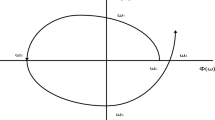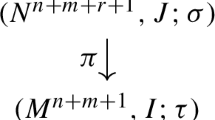Abstract
For general multivariable systems including square ones and fat and thin non-square ones, a unified and analytical optimum control law has been derived for the RTD-A controller. A concise interpretation for the general existence of the control law is provided together with a suggestion for judging this existence in practical applications. Three simulation examples are included to demonstrate the flexibility, friendliness, and excellent robustness, anti-noise performance and dynamic control capability of the RTD-A controller.
Similar content being viewed by others
References
Forbes, M.G.; Patwardhan, R.S.; Hamadah, H.; Gopaluni, R.B.: Model predictive control in industry: challenges and opportunities. IFAC-PapersOnLine 48(8), 531–538 (2015)
Cutler, C.R.; Ramaker, B.L.: Dynamic Matrix Control—A Computer Control Algorithm. In: Proceedings of the Joint Automatic Control Conference, San Francisco (1980)
Xi, Y.G.; Li, D.W.; Lin, S.: Model predictive control—status and challenges. Acta Autom. Sin. 39(3), 222–236 (2013)
Scattolini, R.: Architectures for distributed and hierarchical model predictive control—a review. J. Process Control 19(5), 723–731 (2009)
Rivera, D.E.; Morari, M.; Skogestad, S.: Internal model control: PID controller design. Ind. Eng. Chem. Process Des. Dev. 25(1), 2163–2163 (1986)
Anwar, M.N.; Shamsuzzoha, M.; Pan, S.: A frequency domain PID controller design method using direct synthesis approach. Arab. J. Sci. Eng. 40(4), 995–1004 (2015)
Ogunnaike, B.A.; Mukati, K.: An alternative structure for next generation regulatory controllers: part I: basic theory for design, development and implementation. J. Process Control l6(5), 499–509 (2006)
Mukati, K.; Rasch, M.; Ogunnaike, B.A.: An alternative structure for next generation regulatory controllers. Part II: stability analysis, tuning rules and experimental validation. J. Process Control 19(2), 272–287 (2009)
Anbarasan, K.; Srinivasan, K.: Design of RTDA controller for industrial process using SOPDT model with minimum or non-minimum zero. ISA Trans. 57, 231–244 (2015)
Guan, S.T.; Chu, J.Z.: Research and application of RTD-A controller for multiple input multiple output (MIMO) system. Inf. Control 37(4), 429–434 (2008)
Chu, J.Z.; Du, B.; Chen, J.: Performance analysis and online fuzzy self-tuning of RTD-A controller’s parameters. J. Shanghai Jiaotong Univ. 45(8), 1167–1171 (2011)
Sendjaja, A.Y.; Zhen, F.N.; Si, S.H.; Kariwala, V.: Analysis and tuning of RTD-A controllers. Ind. Eng. Chem. Res. 50(6), 3415–3425 (2011)
Luan, X.L.; Wang, Z.Q.; Liu, F.: Centralized PI control for multivariable non-square systems. Control Decis. 31(5), 811–816 (2016)
Davison, E.J.: Some properties of minimum phase systems and "squared-down" systems. IEEE Trans. Autom. Control 28(2), 221–222 (1984)
Treiber, S.: Multivariable control of non-square systems. Ind. Eng. Chem. Process Des. Dev. 23(4), 854–857 (1984)
He, M.J.; Cai, W.J.; Wei, N.; Xie, L.H.: RNGA based control system configuration for multivariable processes. J. Process Control 19(6), 1036–1042 (2009)
Zou, T.; Li, H.Q.; Ding, B.C.; Wang, D.D.: Compatibility and uniqueness analyses of steady state solution for multi-variable predictive control systems. Acta Autom. Sin. 39(5), 519–529 (2013)
Jin, Q.B.; Hao, F.; Wang, Q.: A multivariable IMC-PID method for non-square large time delay systems using NPSO algorithm. J. Process Control 23(5), 649–663 (2013)
Jin, Q.B.; Liu, Q.: Decoupling proportional-integral-derivative controller design for multivariable processes with time delays. Ind. Eng. Chem. Res. 53(2), 765–777 (2014)
Jin, Q.B.; Du, X.H.; Wang, Q.; Liu, L.Y.: Analytical design 2 DOF IMC control based on inverted decoupling for non square systems with time delay. Can. J. Chem. Eng. 94(7), 1354–1367 (2016)
Yang, S.H.; Wang, X.Z.; Mcgreavy, C.: A multivariable coordinated control system based on predictive control strategy for FCC reactor-regenerator system. Chem. Eng. Sci. 51(11), 2977–2982 (1996)
Zou, T.; Wang, D.; Pan, H.; Yuan, M.; Ji, Z.: From zone model predictive control to double-layered model predictive control. Ciesc J. 64(12), 4474–4483 (2013)
Prett, D.M.; García, C.E.; Ramaker, B.L.: The second shell process control workshop. In: The Shell Process Control Workshop, Butterworths, pp. 325–347 (1987)
Vlachos, C.; Williams, D.; Gomm, J.B.: Solution to the shell standard control problem using genetically tuned PID controllers. Control Eng. Pract. 10(2), 151–163 (2002)
Acknowledgements
This research work was funded by National Natural Science Foundation of China (Project Number: 21676012) and Fundamental Research Funds for the Central Universities (Project Number: YS1404)
Author information
Authors and Affiliations
Corresponding author
Appendix 1: Discretization Method
Appendix 1: Discretization Method
The continuous system model is treated with the equivalent discrete model using the Z-domain discretization method. The zero-order holder is used to obtain the difference equation.
difference equation:
where \(a_{ij }=e^{-T/\tau ij}, b_{ij}=K_{ij} (1-a_{ij}), m_{ij} = \mathrm{round}({\alpha }_{ij}/T), T\) is the sampling time and k = 0, 1, 2, ... for the current moment.
Rights and permissions
About this article
Cite this article
Sun, Y., Chu, J. & Chu, M. RTD-A Control for General Multivariable Systems. Arab J Sci Eng 43, 5891–5903 (2018). https://doi.org/10.1007/s13369-017-3008-y
Received:
Accepted:
Published:
Issue Date:
DOI: https://doi.org/10.1007/s13369-017-3008-y




